Nowadays, it seems like an increasing number of businesses are looking to appear more socially and environmentally conscious.
But, are these projects strategic moves or authentic attempts to work toward a better future?
That’s what we’re here to discuss.
In this article, we’re going to delve into the subject of corporate social responsibility:
- What it is and why it exists,
- The 4 levels of corporate responsibility, and
- How you can build a more socially responsible business.
On the way, we’ll also provide some examples of CSR campaigns that have been realized by various companies as well as how businesses can benefit from incorporating CSR into their strategy.
Having said that, let’s start by defining what corporate social responsibility is, in the first place.

- Corporate social responsibility is a self-regulating business model that prioritizes harm reduction and environmental sustainability.
- Businesses that incorporate CSR into their strategy focus on the triple bottom line, or the 3 P’s: profit, people, and planet.
- CSR is about encouraging ethical behavior on corporate and individual levels.
- Corporations have 4 types of responsibilities: economic, legal, ethical, and philanthropic.
- Corporate social responsibility can be hugely beneficial, namely because it reduces risk factors, improves brand reputation, lowers operating costs, and promotes innovation.
Table of Contents
What is corporate social responsibility (CSR)?
Corporate social responsibility is a self-regulating business model that prioritizes harm reduction and environmental sustainability.
During the 20th century, renowned economist Milton Friedman asserted that companies should stick to their primary mission of maximizing profits without worrying about external factors.
However, the discourse started to shift in the 1980s — a decade ironically known for corporate excess.
In 1982, Kenneth Goodpaster and John Matthews, Jr. published an article titled Can a Corporation Have a Conscience?.
According to the authors, companies not only should consider ethics when making decisions — they must do so.
And so, the CSR movement was born — though it didn’t enter the mainstream until the beginning of this century.
In 2007, a researcher from the Institute of Sustainable Development and Farming at the Hungarian University of Agriculture and Life Sciences, Gergely Tóth, published a book titled The Truly Responsible Enterprise. In it, Tóth provided a more detailed outline of the expectations we might have of a socially responsible business.
According to the book, a socially responsible company should:
- Understand that it is not just a profit-maximizing machine, but a part of a larger system,
- Recognize the challenges that environmental destruction and social injustice pose to our society,
- Take note of the way its operations are contributing to these problems,
- Actively participate in devising viable solutions, and
- Take steps to alleviate its negative impact and create a more sustainable world.
In practical terms, that means a socially responsible company should:
- Comply with legal regulations, norms, and standards,
- Provide its workers with fair working conditions,
- Establish positive relationships with local communities, and
- Reduce its effect on the environment by minding its carbon footprint and optimizing its supply chain.
But, why should companies care about doing any of this?
What is the purpose of corporate social responsibility?
As we have learned, corporate social responsibility is not just about throwing money at the trendiest cause.
Rather, it’s about minimizing the company’s impact on the environment and actively participating in the betterment of society.
But, what’s the point of doing all that?
Well, the less generous interpretation of this philosophy would see it as a risk management strategy at best or a PR campaign at worst.
In other words, a company might incorporate CSR into its business strategy to protect its brand value, rather than to protect employees or improve society.
However, in an increasingly globalized world in which most laws are contained within political borders, multinational companies can play a vital role in promoting the betterment of society and the environment.
The experts we have spoken to tend to subscribe to this more optimistic interpretation of corporate social responsibility.
The purpose of CSR: According to experts
According to the CEO of Stellar Public Relations, Inc., Brenda Christensen, who participated in the creation of global messaging campaigns for companies like Tinder, Apple, McAffee, and more, CSR is about having a positive impact:

“The primary purpose of corporate social responsibility (CSR) is to align a company’s activities with societal and stakeholder expectations, ensuring that business operations positively impact the community, environment, and stakeholders.”
The founder of Serendipity PR & Media, Sangeeta Waldron, who has over 3 decades of publicity, branding, communications, marketing, media, and social media experience, told us that authentic CSR also drives consumer engagement:

“There is increasing international public support for businesses to do better and CSR is driving investment, which has been accelerated by the global COVID-19 pandemic. It creates authentic brands, creates consumer engagement, and avoids greenwashing and crisis management.”
Founder and CEO of HR software company Compt, Amy Spurling, who has nearly 20 years of experience in leadership roles at venture-backed companies, noted that even smaller companies should embrace CSR:

“At its core, CSR is about acknowledging that businesses, no matter the size or industry, operate within a broader societal and environmental context. It’s about understanding that our actions, choices, and strategies have ripple effects on communities, ecosystems, and economies. The purpose of CSR is to ensure that companies are accountable for these effects and are actively working towards creating a positive impact. By embracing CSR, companies send a clear message that they are not just in it for the short-term profit, but are committed to the long-term well-being of their stakeholders and the world at large.”
So, ultimately, authentic CSR isn’t just about preventing malpractice and ensuring that operations are up to code.
Rather, it’s about using innovative solutions to promote sustainable business practices and make the world a better place.
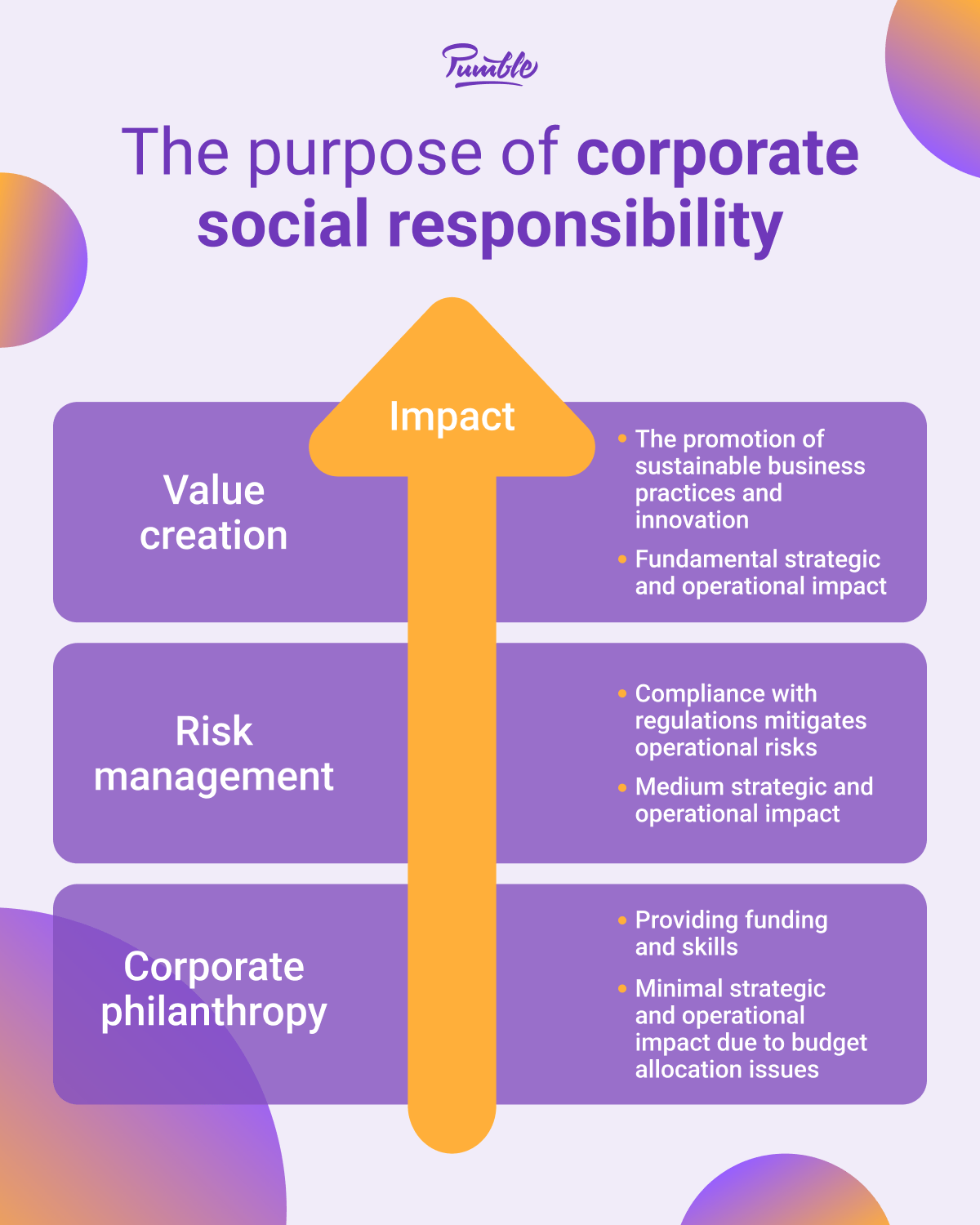
4 Types of corporate social responsibility
As we have learned, authentic corporate responsibility comes from a genuine desire to improve the state of the world.
However, we still only have a vague idea of the avenues through which a company might fulfill its responsibilities.
To gain a better understanding of the different types of corporate responsibility, we’re going to spotlight Archie Carroll’s pyramid of corporate social responsibility.
According to this scholar of CSR, companies have 4 types of responsibilities, which are ranked in order of importance as:
- Being economically profitable,
- Obeying the law,
- Being ethically responsible, and
- Donating to philanthropic causes.
Since the inception of this model in 1991, the tiers have been reshuffled and renamed.
In more recent years, the pyramid has morphed to prioritize ethical responsibility, with economic, environmental, and philanthropic responsibilities building on top of that foundation.
Notably, in that updated model, legal responsibility has been replaced with environmental responsibility.
However, in this article, we will stick to the original 4 tiers of the pyramid.
After all, environmental responsibility should be examined through the lens of ethical and philanthropic considerations.
With that being said, let’s get into this pyramid on the ground floor by dissecting what academics mean when they refer to a company’s economic responsibilities.
Type #1: Economic responsibility
Economic or financial responsibility is placed at the bottom of Archie Carroll’s pyramid of corporate responsibilities.
Unlike the upper tiers, the bottom two are both seen as requirements, rather than merely expected or desirable corporate traits.
So, what does economic responsibility entail?
Well, simply put, it means that a company’s primary responsibility is to be profitable.
Profits allow businesses to sustain themselves, which is the only way they will be able to participate in the other responsibilities we are about to discuss.
Type #2: Legal responsibility
As we have previously stated, mainstream economists of the 20th century mostly subscribed to the intrinsically capitalistic view of corporations.
They should strive to maximize profits at all costs.
However, as humanity has witnessed over the centuries, that kind of model can easily lead to all sorts of abuses — from human rights violations to environmental pollution.
That is why society has produced laws and regulations that have codified the concept of fair business practices.
So, a corporation’s legal responsibility is to obey local, state, and federal laws and regulations.
As a result:
- The government can expect companies to pay their taxes,
- Stakeholders can expect companies to fulfill their legal obligations toward them,
- Employees can expect to be protected from abuses and treated fairly,
- Consumers can expect to receive goods and services that meet legal requirements, and
- The environment will be “minimally” affected by the company’s operations (as required by law).
Type #3: Ethical responsibility
According to Archie Carroll, the third tier of the CSR pyramid pertains to a company’s ethical responsibilities.
Even though behaving ethically isn’t seen as a requirement by society, people still expect companies to behave according to evolving societal morals.
As essential as laws and regulations are, we can all agree that they often leave a lot of leeway within which bad actors can really spread their wings.
For example, if the law doesn’t codify certain environmental protections, who’s to stop a corporation from exhausting natural resources or polluting the environment?
Similarly, if a certain marginalized group isn’t recognized by laws and regulations, does that mean companies shouldn’t recognize or accommodate employees who belong to that group?
According to Carroll, these issues are the ones that can be resolved through ethical considerations.
A company’s ethical responsibility might lead it to:
- Expand employee benefits past the minimum legal requirements,
- Provide diversity training to hiring managers,
- Reduce environmentally harmful practices,
- Seek out ethical and sustainable suppliers, and
- Disclose any operating concerns to stakeholders in a timely, honest, and respectful manner.
In essence, this type of corporate social responsibility drives corporations to avoid harm when possible.
Type #4: Philanthropic responsibility
Last but certainly not least, we have the tip of Carroll’s CSR pyramid.
Once a company has satisfied the other conditions we have discussed, it should make an effort to become a positive influence on society through philanthropic activities.
However, that shouldn’t necessarily be limited to charitable donations.
Instead, philanthropic responsibility could also influence the company to:
- Sponsor fundraising events that are important to the local community,
- Work with suppliers and partners whose values align with the company’s mission, and
- Offset its negative environmental impact through volunteer actions (such as planting trees) and targeted research funding.
According to Carroll, this type of CSR is not seen as a requirement or even something that is expected of all companies.
However, whether ethical and philanthropic responsibility are still seen as optional is debatable.
According to a quantitative survey conducted by Certus Insights, 70% of consumers want to know what companies are doing to address social and environmental issues.
As much as 73% have the same expectations of small companies as well.
So, it’s safe to say that philanthropic efforts are becoming an increasingly important consideration in the eyes of consumers.
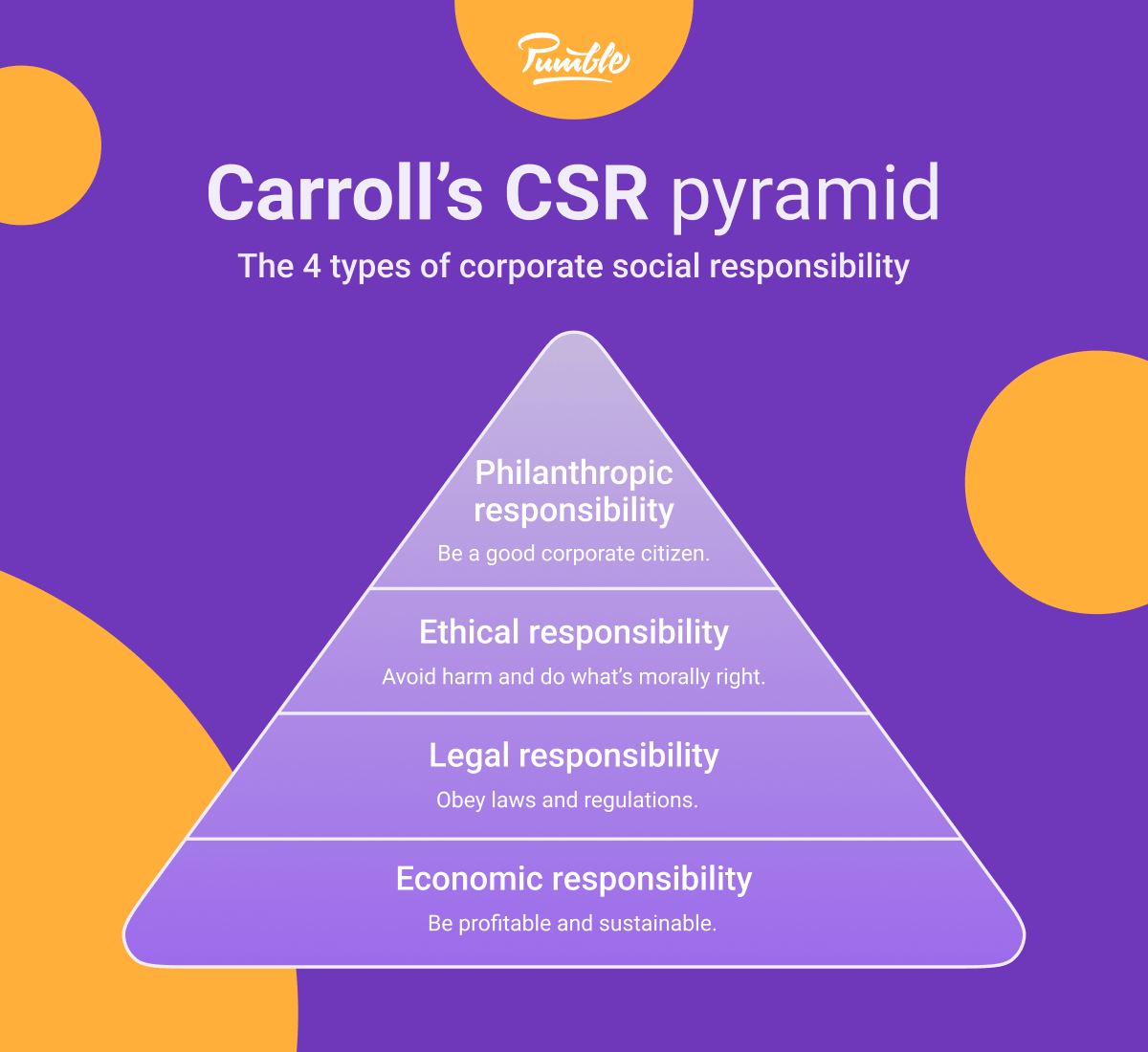
Examples of corporate social responsibility
At this point, many corporations have highly publicized sustainability campaigns as a result of their corporate responsibility activities.
Some of them identify what they see as the biggest social and environmental issues in the world and build their CSR campaign around that.
Others focus their efforts on issues that reflect their company’s product or mission.
To illustrate that point, we’re going to briefly discuss the CSR efforts of the following companies:
- Microsoft,
- IKEA,
- LEGO,
- Unilever, and
- Patagonia.
So, without further ado, let’s get started.
Example #1: Microsoft
Microsoft is the prime example of a company that has a comprehensive CSR strategy that affects all 5 of the categories highlighted in The Truly Responsible Enterprise:
- Internal codes of conduct,
- Management standards,
- Reporting,
- Labels and certification, and
- Socially responsible investment.
In its annual reports, the company outlines the results of its CSR goals in 4 distinct categories:
- Expanding opportunity by growing access to digital skills and equipment,
- Earning trust by developing tech responsibly, respecting consumer privacy, and advancing cybersecurity,
- Protecting fundamental rights by promoting responsible business practices, expanding accessibility, and empowering humanitarian organizations, and
- Advancing sustainability by pushing to become carbon-negative, water-positive, and zero waste by 2030.
Even though these goals are somewhat broad, they still reflect Microsoft’s values of tech innovation and digital security.
The following quote by Microsoft’s Chairman and CEO, Satya Nadella, sums up the company’s approach to CSR:
“Our mission to empower every person and every organization on the planet to achieve more has never been more urgent or more necessary. Our actions must be aligned with addressing the world’s problems, not creating new ones. At our core, we need to deliver innovation that helps drive broad economic growth. As a company, we will do well when the world around us does well.”
— Satya Nadella
Example #2: IKEA
Starting in the early 1980s and through the mid-aughts, IKEA came under fire when investigations revealed the negative social and environmental impacts of its business practices.
Yet, since then, the company has transformed its public image through a series of sustainability initiatives, which are mostly focused on:
- Empowering consumers to live healthier and more sustainable lives,
- Becoming a more circular and climate-positive business by using regenerating resources and improving biodiversity, and
- Providing fair and equal treatment to its employees.
On top of that, the company has documented their efforts in addressing various social issues, including:
- LGBT+ inclusion,
- The refugee crisis in Syria and Ukraine,
- Rural communities in India and Bangladesh (where the company sources its hand-woven products), and even
- Modern slavery.
IKEA proves that a company can recover from bad press by committing to right its wrongs and incorporating social and environmental responsibility into its business practices.
The company itself sees this as the only way to ensure its longevity, as evidenced by the following quote from the company’s Sustainability Strategy report:
“We must transform our way of working — from linear to circular, from only using to also regenerating resources. As a business reliant on natural resources and people, it will also mean that we can secure the future of the IKEA business, value chain, and the livelihoods of the millions of people that contribute to it.”
Example #3: The LEGO Group
The LEGO Group is an interesting example of a company that built its CSR from the inside out.
In other words, it focuses on issues that are important to its customers.
The company’s Responsible Business Principles outlined its responsibilities towards children, people, and the environment.
In their commitment towards the people they work with, their principles ensure that all work is voluntary, and their workers are treated with respect and protected against abuses.
The company also spotlights issues of child labor and makes sure workplaces are family-friendly — both issues that coincide with the company’s core values.
Most notably, though, the company strives to minimize the environmental impact of its business operations by embracing sustainability and documenting its efforts.
In an interview for the 2018 edition of CEO Journal, the CEO of The LEGO Group, Niels Christiansen explained the purpose of the company’s extensive CSR efforts:
“As a provider of play experiences, we must ensure that our behaviour and actions are responsible towards all children, and towards our stakeholders, society, and the environment. We are committed to continue earning the trust our stakeholders and customers place in us, and we are always inspired by children to be the best we can be.”
— Niels Christiansen
Example #4: Unilever
When asked to provide an example of a CSR initiative that impressed them, one of the experts we consulted, Brenda Christensen, highlighted Unilever’s efforts:

“One of the most iconic instances of CSR in action was when Unilever launched its Sustainable Living Plan. This ambitious initiative aimed to halve the environmental footprint of their products, improve the health and well-being of billions, and enhance the livelihoods of millions by 2020. It showcased a holistic approach to CSR, encompassing environmental, social, and economic dimensions.”
Unilever, for the uninitiated, is the consumer packaged goods company most known for its ice cream brand Ben & Jerry and personal care brands like Axe, Dove, and Rexona — though those are only some of the brands under Unilever’s purview.
Like any company of its scale and history, Unilever has had its share of environmental controversies.
However, the Sustainable Living Plan Christensen mentioned was a big step forward.
Published in 2010, the plan outlined goals the company would be striving to reach by 2020, many of which were accomplished.
Still, efforts to improve across various categories that were listed in the original document continue, as the company has set new objectives to work towards by 2030.
As Rebecca Marmot, Unilever’s Chief Sustainability Officer, wrote for the company’s summary of the results of its Sustainable Living Plan, there’s more work to be done:
“Our journey to make sustainable living commonplace continues. We need to move even further, and faster. The challenges we need to tackle — climate change, plastic pollution, social inequality, improving health and wellbeing — are huge. They call for action that goes beyond the changes that one business can make alone.“
— Rebecca Marmot
Example #5: Patagonia
Last but not least, we’d like to spotlight the CSR efforts of Patagonia, which were brought to our attention by Amy Spurling:

“One [CSR initiative] that stands out to me is the work of Patagonia (I’m a huge fan), the outdoor clothing and gear company. Their dedication to environmental and social causes is truly commendable. From donating a significant portion of their profits to environmental causes, to actively promoting sustainable and responsible consumption, Patagonia consistently sets an example of what CSR can look like when integrated deeply into a company’s DNA. Their actions are aligned with their values, and they’re not afraid to take a stand on issues that matter to them, even if it means challenging the status quo.”
On its sustainability page, Patagonia first acknowledges that everything the company makes has an impact on the planet.
Following that bold statement, the company explains the exact steps it’s taking to ensure social, environmental, and animal welfare throughout the manufacturing process.
As an outdoor equipment manufacturer and retailer, it makes sense that Patagonia prioritizes the environment in its CSR efforts.
That resolve is made even more evident by the company’s 50th-anniversary statement:
“For our 50th year, we’re looking forward, not back, to life on Earth. Together, let’s prioritize purpose over profit and protect this wondrous planet, our only home.”
Benefits of CSR
Ultimately, the examples we have just listed are just some of the most notable instances of corporate social responsibility.
They are, by no means, the only companies that are taking their corporate sustainability seriously.
Indeed, thousands of corporations have taken steps to become better corporate citizens.
That means that all those companies have determined that the benefits of building a strategy of corporate social responsibility are numerous — and that the risks of not having one are too great.
So, let’s take a moment to reflect on those benefits. Why are all these companies jumping on the CSR bandwagon?
Benefit #1: Risk management
Even though risk management should never be the primary driver of a company’s CSR initiatives, it’ll certainly be one of their benefits.
Brenda Christensen, a PR expert we contacted, remarked upon the potential of CSR efforts to stave off controversies:

“CSR initiatives can help mitigate potential risks and controversies related to environmental or social concerns.”
After all, if a company is committed to acting ethically and preserving the environment, it’ll automatically be on track to avoid — or at least reduce the impact of — certain controversies.
On top of that, Amy Spurling noted that being proactive in this way may help companies avoid legal issues later on:

“Proactively addressing societal and environmental issues can help companies avoid potential legal or regulatory pitfalls down the road.”
Moreover, low-risk businesses tend to attract investments more easily, as Sangeeta Waldron pointed out:

“[Corporate responsibility] attracts investors because businesses with authentic CSR are low risk.”
With all this in mind, it’s no wonder that as many as 76% of companies report on their CSR activities as a way of reducing brand reputation risk, according to a survey by Zipdo.
Benefit #2: Positive brand reputation
Corporate social responsibility can also be a powerful marketing tool — though that also shouldn’t be the primary purpose of a company’s sustainability efforts.
Brenda Christensen notes that having a positive brand reputation can also affect a company’s bottom line as well as its reputation as an employer:

“Positive CSR efforts lead to a better brand image, making companies more appealing to consumers and potential employees.”
Amy Spurling voiced a similar opinion while focusing on the customer loyalty aspect of a brand’s reputation:

“Companies known for their CSR initiatives are often more respected and admired. This can lead to greater customer loyalty and brand differentiation.”
And, if that doesn’t convince you, take it from one of the pioneers of corporate sustainability — the former CEO of Interface, Ray Anderson.
Upon making an effort to reduce his company’s fossil fuel consumption, Anderson remarked on the success of the campaign without forgetting its primary goal:
“There is no amount of slick advertising that would have created the goodwill that this effort has created. You are talking about authenticity at its very, very best. This is a better way to make a bigger profit and a more legitimate one, at that, because it doesn’t come at the expense of future generations and not at the expense of the earth.”
— Ray Anderson
If consumers, investors, and regulators alike see your company in a favorable light as a result of your honest efforts to improve society and the environment, that’ll certainly be a welcome bonus on top of the real value your CSR efforts will bring to the world.
Benefit #3: Stakeholder trust
Having a positive brand reputation due to the successful execution of various CSR initiatives will inevitably increase the level of trust people have for your company.
According to Brenda Christensen, corporate responsibility engages stakeholders across the board:

“[CSR] fosters trust among stakeholders, including shareholders, customers, and employees.”
So, investors aren’t the only ones who feel more at ease when companies behave ethically and operate sustainably.
Other stakeholders, such as employees, customers, suppliers, and even local communities and governments, will also experience a heightened sense of trust in your company as a result of your CSR activities.
Benefit #4: Employee engagement and satisfaction
In a world in which only 21% of employees feel engaged at work, anything that nudges that number up is a godsend.
As it happens, CSR initiatives reportedly do just that — especially when it comes to younger employees, as Sangeeta Waldron told us:

“Gen Z wants to work with companies that have strong CSR.”
Of course, this shouldn’t come as a surprise, considering that WeSpire named Gen Z the “first generation to prioritize purpose over money.”
As for the other generations, well — 64% of Millennials reportedly wouldn’t take a job with a company that didn’t have strong CSR values.
Moreover, according to the Zipdo survey we have previously mentioned, 83% of employees would even consider quitting their job if their company displayed irresponsible CSR practices.
Conversely, having an employer who shares one’s values seems to have a positive effect on employee morale, as Amy Spurling noted:

“Employees, especially the younger generation, want to work for companies that align with their values. CSR initiatives can boost morale, job satisfaction, and loyalty.”
In other words, CSR:
- Improves employee retention,
- Promotes a spirit of collaboration and a generally positive company culture, and
- Attracts job candidates with similar values to the ones the company holds.
Benefit #5: Cost reduction
If risk management, positive brand reputation, and happy stakeholders aren’t enough to convince you to lead your company down the socially and environmentally responsible path, consider the financial aspect of the equation.
Remember, a socially responsible company still won’t stray too far from the primary goal of any business enterprise — profit maximization.
Rather, CSR adds 2 more variables into the mix, forcing businesses to consider the triple bottom line, or the 3 P’s:
- Profit,
- People, and
- Planet.
According to Bob Willard, an expert on corporate sustainability and author of The New Sustainability Advantage: Seven Business Case Benefits of a Triple Bottom Line, companies that incorporate CSR into their business strategy can increase their profits by 51–81% — depending on the size of the company.
On the one hand, that increase in profit partly comes from decreased spending, as Amy Spurling pointed out:

“Sustainability efforts, a part of many CSR programs, can lead to cost savings through energy efficiency, waste reduction, etc.”
Secondly, a company could also see a more sustainable profit come in from a loyal customer base, as Brenda Christensen suggested:

“Ethical and sustainable business practices often translate to long-term financial gains by ensuring sustainable operations and customer loyalty.”
The positive brand reputation and stakeholder loyalty that is achieved through CSR efforts also have the added benefit of increasing a company’s funding opportunities through investments.
And, if that’s not enough of a financial incentive either, we should also mention that many companies start incorporating CSR into their business strategy due to tax incentives.
Benefit #6: Innovation
With all that extra profit and the active participation of employees, corporations that practice social and environmental responsibility often become industry leaders and innovators in their field.
But, how is CSR connected to innovation?
Well, companies with strong CSR might start reconsidering the way they hire and manage employees, the way they source products and resources, and even the value they bring to their customers.
This leads employees to suggest more socially and environmentally responsible actions the company can take to improve its sustainability initiatives.
Even though practicing sustainability can be somewhat limiting, those restrictions can lead to all sorts of breakthroughs.
For example, if lithium-ion batteries (which power most of the electronic devices on the planet) aren’t a sustainable source of energy, people will start considering alternative solutions.
Honda and Toyota have both announced their commitment to create electric vehicles that run on solid-state batteries.
In addition to having a greater energy storage capacity, a longer lifespan, and faster charging capabilities than standard lithium-ion batteries, solid-state batteries are also considered a significantly safer and more sustainable power source.
These companies understand that innovating for the sake of sustainability could be the only way to ensure their own longevity — which is something Amy Spurling has also noted:

“Companies that consider the broader impact of their actions are more likely to make strategic decisions that ensure sustainability and longevity.”
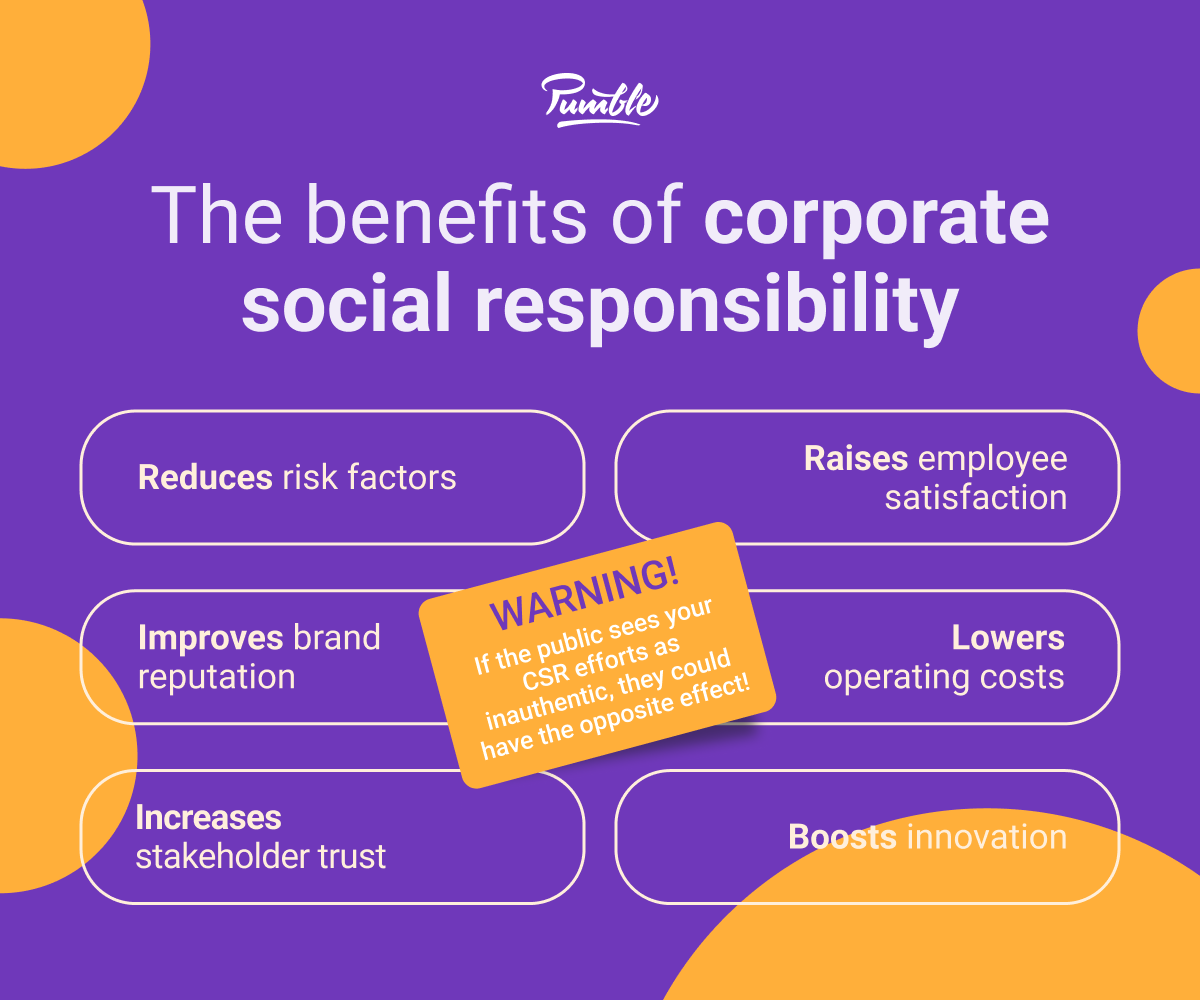
The dark side of corporate social responsibility
As we have established, true corporate social responsibility needs to be authentic and true to the company’s values.
Otherwise, the public might perceive those efforts as lacking sincerity and claim that the company is only practicing social and environmental responsibility to stave off bad press.
In fact, according to the Certus Insights survey we have previously mentioned:
- Only 9% of consumers say that they believe all corporate claims about social responsibility (a level of trust that’s, interestingly, more prevalent among Millennials at 19% than Boomers at 2%), whereas
- 67% of consumers say that they believe those claims only some of the time.
In any case, these numbers show that consumers are fairly skeptical about corporate claims about sustainability initiatives.
By all accounts, this suspicion exists due to the overuse of deceptive corporate tactics like greenwashing.
This practice of using false environmental claims in marketing campaigns takes advantage of consumers’ desire to invest in sustainable products and companies.
But, as Amy Spurling pointed out, true CSR shouldn’t be just about optics:

“True CSR goes much deeper than symbolic gestures, though. It isn’t just about optics; it’s about meaningful actions and systemic changes within an organization. Merely updating a logo or making a one-time statement without the backing of real policies, initiatives, or tangible support, is superficial and performative. It’s essential that companies understand the difference between genuine allyship and token gestures.
True CSR means actively incorporating values into every aspect of a business, whether it’s supporting LGBTQ+ rights, promoting sustainability, or any other cause. When companies use symbols without substance, they risk undermining the very cause they’re claiming to support and may face backlash for perceived insincerity. It’s always better to prioritize actions that make a genuine difference over surface-level displays.”
So, how do we solve this crisis of authenticity?
How to build a socially responsible business
Ultimately, a single company’s authentic commitment to CSR won’t cure the public of its rightfully earned skepticism.
However, there are ways to prove our sincerity to the consumers — namely, by building (or restructuring) companies around social and environmentally conscious values.
There are several steps we can take to achieve that result, including:
- Defining our brand values,
- Considering our impact,
- Starting within,
- Engaging stakeholders,
- Collaborating with experts,
- Seeking certification,
- Increasing accountability, and
- Continuous learning.
Let’s see what these steps might look like in practice.
Step #1: Define your brand values
If you’re just starting to think about creating a CSR strategy, you’ll need to define your company values first.
As Sangeeta Waldron told us, this is work that needs to happen before you ever announce your intentions publicly:

“First, define the brand values so everyone within the business/organization understands what they are; build these values into the business strategy, so they are baked-in within the heart of the organization from top-down, bottom-up, and sideways. Analyze all internal streams, external partnerships, and supply chains and make sure that they are joined up with the brand values — do this before you announce them externally.”
So, how can you determine a company’s values?
Well, you can start with your main output and go from there.
For example, because The LEGO Group produces toys, much of their responsibility efforts are focused on creating a better world for kids.
Similarly, since Patagonia’s products are meant to be worn outdoors, the company’s CSR initiatives are mainly focused on preserving the environment.
Still, if you find defining your company values difficult — remember that your company is made up of people.
If you make an effort to understand those people and their needs and incorporate them into your CSR initiatives, they will be much more meaningful and authentic.
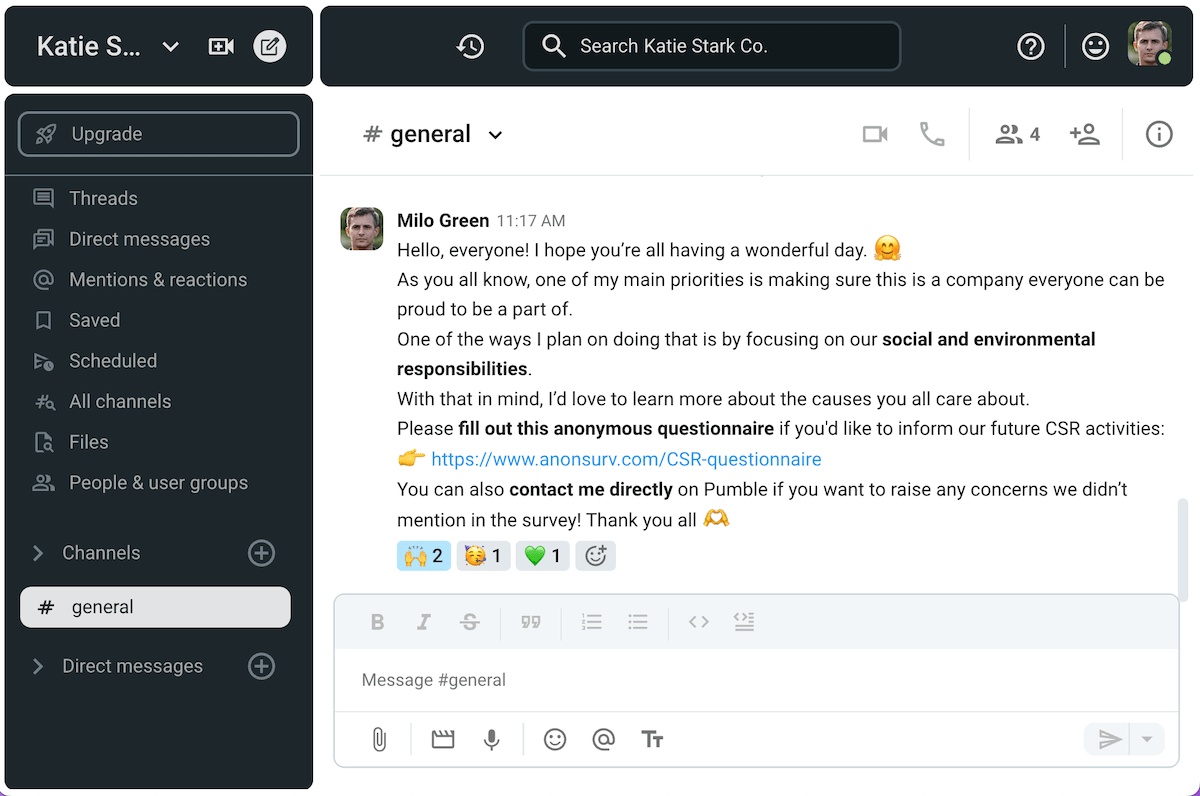
Step #2: Consider your impact
Once you have identified your company values, you should determine your actual impact on the world and understand where the discrepancies between that and your values are.
What are the direct and indirect impacts of your products or services?
For example, if Patagonia prioritized nature, but internal investigations revealed that its operations negatively impacted the environment, the main goal of the company’s CSR campaign would be to right those wrongs.
Even companies without a physical product — such as those working in the SaaS industry — have to consider the carbon footprint of their business operations.
To make it easier, you can analyze your company’s impact through the lens of Archie Carroll’s pyramid of corporate social responsibility to make sure your company is:
- Obeying local, state, and federal laws and regulations,
- Behaving ethically towards suppliers, employees, and consumers, and
- Taking steps to reduce and offset its negative environmental and social impacts.
Understanding your company’s impact will help you create an actionable CSR strategy complete with specific goals to work towards.
Step #3: Start within
Even though CSR is often seen as a collection of outward-facing projects, the most successful CSR initiatives start within the boundaries of a company and slowly extend outwards.
With that in mind, the next logical step has to do with the first 2 of the 5 segments of a CSR strategy, as outlined in The Truly Responsible Enterprise.
In other words, you must start by improving the internal codes of conduct and management standards.
Providing awareness and skills training to employees and management is a great place to start.
That should communicate your company values internally.
However, as Sangeeta Waldron told us, it’s just as important to publicize those values on external channels:

“Ensure that the brand values are communicated internally and across all external communications with all audiences and stakeholders. Ensure that they are integrated with the business’s brand and its brand storytelling across the website, social media, press releases, and statements.”
After making sure that the company’s internal structure is solid, you’ll be able to start working on issues like the company’s carbon footprint, energy and water consumption, supply chain, and community engagement.
Step #4: Engage the stakeholders
When creating a CSR strategy, it’s best to get the stakeholders involved from the get-go, according to Brenda Christensen:

“Involve employees, customers, and other stakeholders in decision-making processes.”
Amy Spurling concurred, noting that engaging employees in this way would foster a culture of collaboration within the company:

“You’ll need to integrate CSR throughout your business and operational strategy. It shouldn’t be an afterthought. This includes fostering a culture where employees feel empowered to contribute to CSR initiatives. Their insights and enthusiasm can be invaluable.”
There are several ways to get employees on board with CSR efforts, including:
- Putting together an employee-lead team to identify causes the company should support,
- Creating an anonymous system employees can use to suggest changes in the company, and
- Organizing volunteer work as a company.
Companies can use similar tactics to engage suppliers and local communities in their CSR efforts.
Step #5: Collaborate with experts
If you’re not entirely sure how to put your best foot forward, you can always phone a friend — or a friendly expert!
Amy Spurling recommends getting in touch with more experienced collaborators who can help you envision and execute your CSR strategy:

“You won’t be an expert in this – and that’s okay! There are plenty of experts with whom you can collaborate. Consider partnering with NGOs or experts in areas where you want to make an impact. They can provide invaluable guidance and resources.”
If this is the route you want to take, you can have a team in charge of CSR research organizations or experts who could help you put your ideas into action.
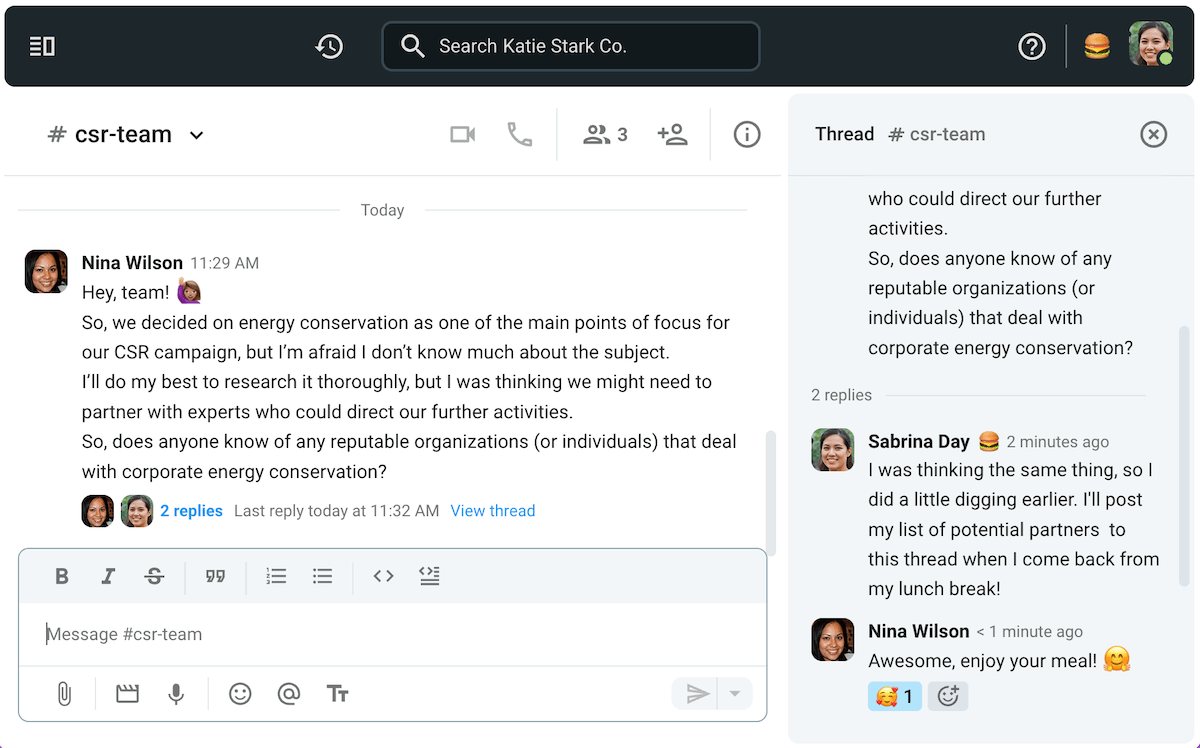
Step #6: Consider seeking certification
When you begin seeing the results of your hard work, you might start to feel confident about your CSR strategy.
At that point, you might decide to seek certification to prove the results of your efforts.
If your company produces a physical product, it may be eligible for eco-labels in accordance with your industry’s standards.
Alternatively, if you’ve managed to achieve sustainability in your business practice, you could look into becoming certified as a socially and environmentally responsible company.
There are many different types of socially responsible corporate designations, including:
- Certified B corporations (or benefit corporations),
- Social Purpose Corporations or Flexible Purpose Corporations, and
- Low-profit limited liability companies.
If you wanted to achieve a B-corp status, you’d have to go through a B Impact Assessment, through which your company’s positive impact on workers, communities, customers, suppliers, and the environment would be graded.
However, even if you don’t go for the certification, we still recommend getting that environmental performance evaluation.
If nothing else, doing so will give you a better understanding of the parts of your sustainability campaign that need more work.
Step #7: Increase accountability
Reporting the results of your efforts is a crucial aspect of any CSR campaign.
That’s why so many companies have a sustainability page on their website detailing the steps they have taken to make their business more environmentally conscious.
The purpose of this is to ensure accountability and transparency, which, according to Amy Spurling, builds trust with stakeholders:

“Throughout this process, be as transparent as possible because transparency builds trust. Share your CSR goals, progress, and challenges with stakeholders.”
Brenda Christensen also added that these reports should, ideally, be done on a regular basis:

“Regularly measure your CSR outcomes and be transparent in reporting them.”
Most companies issue yearly PR reports about their achievements and the steps they’ll take toward reaching their long-term CSR goals.
However, if you have a department of your company that’s specifically dedicated to enacting your CSR strategy, you could issue more frequent reports, too.
Step #8: Keep learning
Once you come close to reaching the goals of your social and environmental responsibility campaign, you might feel comfortable enough to take your hands off the wheel.
However, in doing so, you would be neglecting a huge aspect of corporate social responsibility — adaptability.
After all, even the social and environmental values we now accept as a society are ones that we evolved into.
A century ago, most businesses wouldn’t have bothered to ensure protections for marginalized workers or think about ethical supply chains.
But, as Brenda Christensen would say, the world of CSR is dynamic:

“The world of CSR is dynamic. Be prepared to evolve your initiatives in line with global trends and local needs.”
Amy Spurling echoed Christensen’s sentiments, adding that staying informed is crucial:

“Continuously educate yourself on best practices, emerging trends, and [get] feedback from stakeholders to refine your approach.”
Start creating your CSR strategy with Pumble
Corporate social responsibility envisions a world in which businesses can care about things other than profits.
In other words, companies can be:
- Economically efficient,
- Socially equitable, and
- Environmentally sustainable.
The first step for creating CSR strategy is defining your company values.
To do that, start with understanding the needs of people within your company and incorporating them into your CSR initiatives to make them more authentic and meaningful.
Luckily, tools like Pumble, a team communication app, can help with that. Thanks to its numerous feature, Pumble can help you:
- Conduct surveys in private channels or groups to better understand your employees,
- Improve your internal codes of conduct and announce them via public channels, and
- Put together a team dedicated to CSR that will collaborate together, hold meetings, and discuss potential changes that can make the company more socially responsible.
Excited to start making CSR strategy with Pumble? Start for free today!




